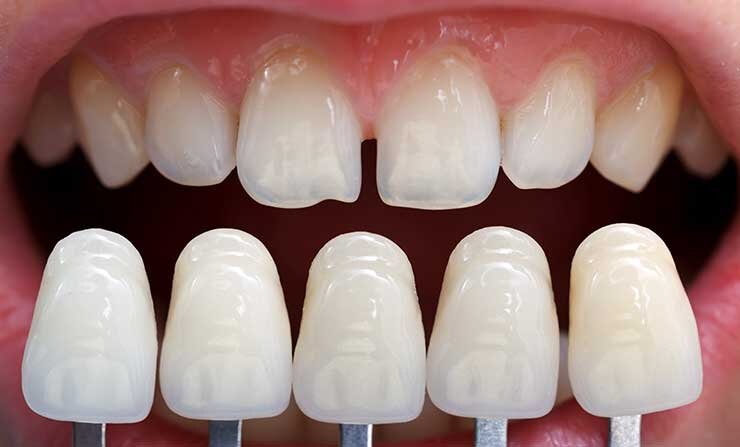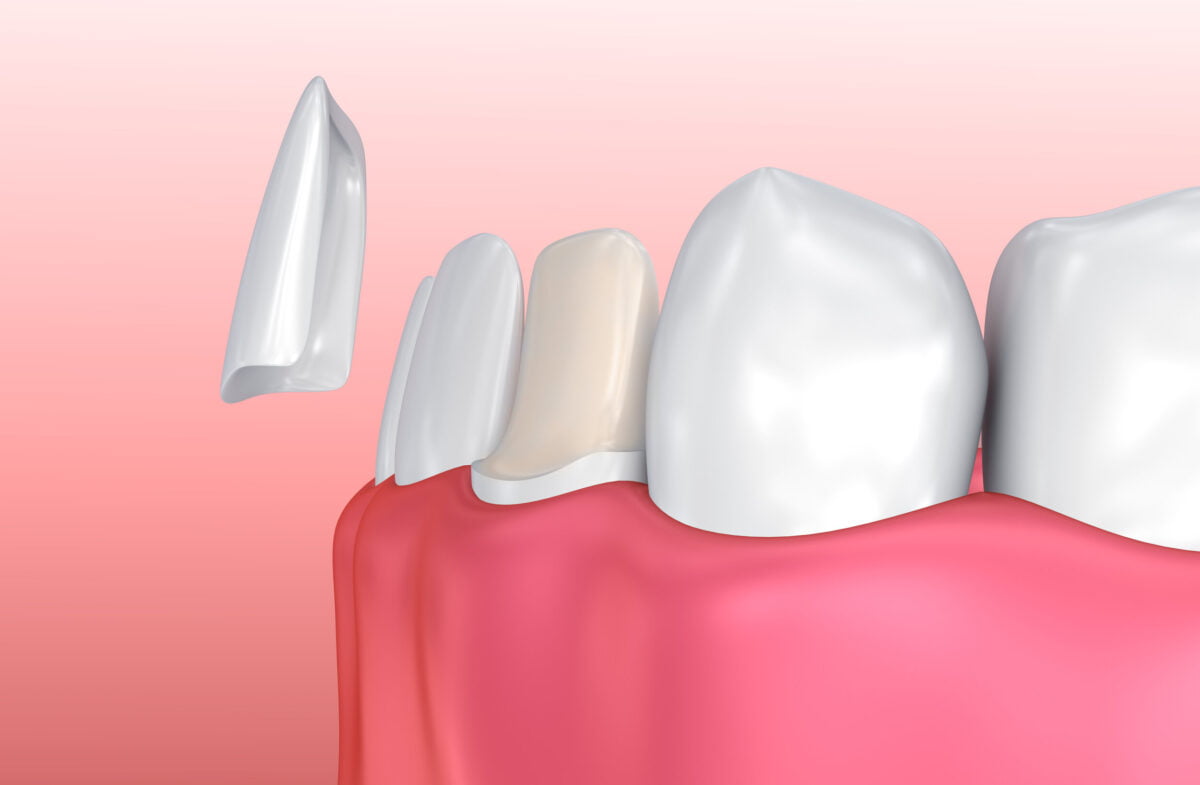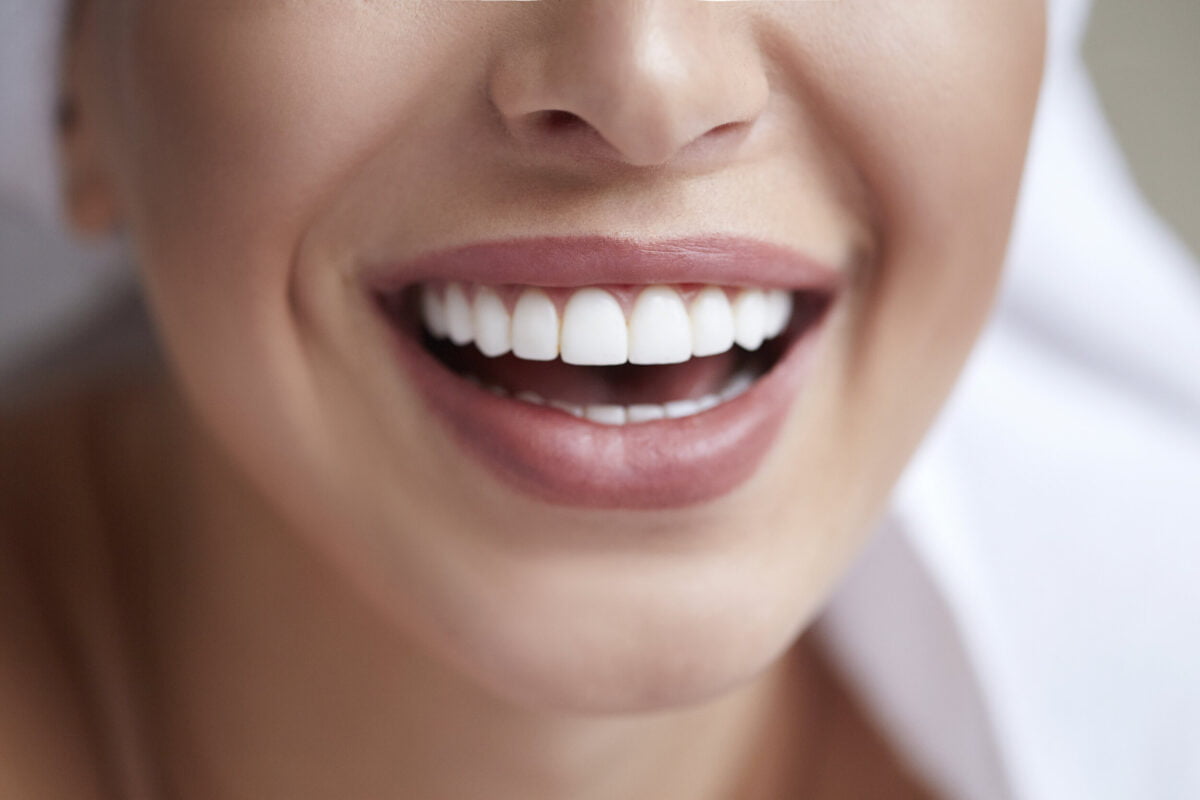Made from porcelain or composite materials, dental veneers are thin shells permanently bonded to the surface of teeth. They are largely used for cosmetic reasons (including chipped, broken, discoloured, or unevenly sized teeth), and most commonly placed on the top front four, six, eight or ten teeth. Veneers can be placed over a single tooth, or you may want up to ten veneers made in order to create a symmetrical smile.
How is a Veneer Different from Implants or Crowns?
Veneers cover the front surface of a tooth (visible when you smile), whereas an implant is an artificial replacement for the whole tooth, and crowns cover the entirety of an existing tooth. Check out our blogs on implants and crowns for more information.
When Would My Dentist Recommend Veneers?
Your dentist will likely recommend veneers if you are unhappy with your smile and have one or more of the following:
-
broken or chipped teeth
-
severe discoloration or uneven coloring that can't be fixed with whitening
-
gaps in the teeth
-
smaller-than-average teeth
-
pointed or unusually shaped teeth
Veneers are not a good choice for people with unhealthy teeth (those with cavities or gum disease), weakened teeth (as a result of decay, fracture, large dental fillings), or for those who don't have enough existing enamel on the tooth surface. In those instances, we would recommend a crown or implant (depending on the patient's dental situation). If one has gum disease or cavities, these conditions should be treated prior to the consideration of cosmetic enhancements such as veneers.
Types of Veneers
Traditional Veneers
Traditional veneers are more resistant to staining, as they aren't porous like tooth enamel. They're a great option for those wanting long-lasting cosmetic results, and especially in cases where teeth have had multiple fillings or have heavy staining. Broken or chipped teeth, smaller than average teeth, and unusually shaped teeth are often great candidates for restoration with traditional veneers.
Traditional veneers are considered permanent, as our expectation is that they will last a minimum of 10 years on your teeth. Ten years is a minimum expectation for a veneers' lifespan. Ideally, they will last a lifetime. The preparation of a tooth for a veneer requires the removal of some of the tooth structure on the front surface of the tooth, the biting edge, and in between the tooth. It is always our objective at Toothworks Dentistry to be as conservative as is possible in the preparation of your teeth for veneers.
Lumineers
Lumineers are a proprietary brand of porcelain veneers that have been made famous by effective marketing and widespread use within the dental community. They gained popularity because they were a much less invasive way to provide patients with similar aesthetic outcomes to traditional porcelain veneers. Lumineers require less preparation (ie. less removal of tooth structure) than traditional veneers, making them less invasive. When providing our patients with this treatment option, we often do not have to even freeze our patients. Lumineers are thinner (0.4mm) than traditional veneers (0.75-1.0mm), but because of this, they tend to suffer more breakage with long term use. We still expect them to have long-term success (greater than 5 years of life), but find that occasionally we have to replace or repair them, as they are more likely to chip and break. Because they're thinner, they are also not the best option for masking or changing the shade of severely discoloured teeth.
Lumineers are still considered permanent restorations. However, due to how thin they are, they can be removed with minimal damage to your teeth.
Chairside Veneers (Bonding)
This is the least expensive and least invasive way to modify the shape and shade of your teeth. These are often referred to as "bonding" or "composite build-ups" or "composite veneers." We call them chairside veneers, because instead of having a laboratory fabricate your veneers with porcelain, your veneers are fabricated in your mouth, by your dentist, as you are reclined in the dental chair.
The major benefits of this treatment are:
-
They cost ⅓ to ½ that of a traditional veneer / Lumineer.
-
They require virtually no removal of existing tooth structure.
When we create chairside veneers, we chemically etch your enamel so that we can bond tooth-colored filling material to the teeth we are treating. We will then use our dental instruments and drills to contour the filling material to an ideal tooth shape. We will also contour the material to fit in your bite against the opposing teeth. This process is almost entirely additive (meaning we are adding to your teeth), and so doesn't involve much, if any natural tooth reduction.
The disadvantages to the chairside veneer are:
-
They are not the best option for masking severe tooth discolorations (composite filling material is quite translucent).
-
The composite filling is more prone to chipping and breaking than porcelain.
-
Composite filling material picks up stain at a faster rate than porcelain and enamel.
Due to the latter of the two disadvantages listed, chairside veneers have the shortest lifespan of all veneer alternatives. We expect them to last 2-5 years, though some patients have had chairside veneers last 10+ years.
The Process
Before a decision is made about veneers, a consultation with your dental professionals at Toothworks is of value. We are proud to offer free consultations to discuss your smile goals, and whether or not veneers are a procedure that will help you achieve your ideal smile. As mentioned, ensuring that your teeth and gums are in optimal health comes first. Once those two prerequisites are taken care, of cosmetic enhancements like veneers can take place.
We will need to establish if veneers make sense when considering your goals. Are your teeth stained? Can the staining be resolved with whitening alone, or is a porcelain veneer necessary to hide the unsightly stain? Do you dislike the shape of your teeth? Is it tooth wear that is contributing to the misshapen teeth? If so, is it your bite or other habits that are contributing to the change in your tooth shape? There are a myriad of questions that we will need to answer, to ensure that we are taking the right approach to achieving the smile of your dreams. The more we learn about you, the more prepared we are to advise you on what treatment is best for you.
Once we go through the above-mentioned "discovery" process, and you've decided that veneers are the best option available, it's time to get started! The first step in veneer treatment is deciding how you want your smile to look when we're done. We will chat about your smile design, and gather the data we need to offer you a preview of the final outcome. You'll then come in for such a preview, which can be performed by placing some temporary veneers in your mouth than you can "try" for about an hour in our office. It will allow you to see how the final product will change your smile / tooth shape / tooth length. If you love it, we can start prepping your teeth the same day.
The third step of the process is the preparation of your teeth for the porcelain restorations. If you've chosen composite veneers, this would be the point at which we build your chairside veneers in-office. If you're going with porcelain veneers, we will be removing some of the tooth structure, taking new digital moulds of your teeth, and making you some temporary veneers to wear for a period of two weeks.
The final step, if you've chosen porcelain veneers, will be two weeks after the third step. On this day we will be removing the temporary veneers, then trying-in and cementing the permanent veneers. If you've chosen traditional porcelain veneers, you will likely be visiting our lab to finalize the shade/color of your new veneers. We have very passionate professionals who are responsible for making our porcelain restorations. They will ensure you are thrilled with the outcome, prior to you attending our office to have the porcelain veneers permanently fastened to your teeth.
Once the veneers are in your mouth, we will do our utmost to ensure that you are pleased with the esthetic result, as well as your bite / ability to chew. We encourage all of our veneer patients to have a night guard made, to prevent these new restorations from chipping or breaking from nocturnal tooth grinding. Tooth to tooth contact is the most likely culprit for veneer breakage. A night guard is one of the best ways to ensure the utmost longevity of your new smile.
How Long do Veneers Last?
Like many other dental treatments, the recovery period for veneers is extremely short. You should be able to eat and chew as normal once the freezing wears off, and there is typically no pain associated with these procedures.
With proper care and good dental habits, porcelain veneers should last at least 10-15 years before needing to be replaced. Composite veneers should last 5-10 years. Our advice for getting the most out of your veneers is:
-
Invest in a splint (night guard) or retainer and wear it every night.
-
Don't chew on hard objects (ie. pens, ice, or your fingernails)
-
Never use your teeth to open packaging (this causes them to grind against each other, wearing the enamel/veneers).
-
Try not to chew with your front teeth — use your molars to reduce wear on your veneers.
-
If playing sports, wear a mouthguard.
Interested in Dental Veneers?
If you're self-conscious about your smile, there may be other options you want to try first, such as orthodontically aligning, or whitening your teeth.
You can book a free consultation with Dr. Withanachchi or Dr Chahal to see if veneers are right for you. Our team will coordinate with your insurance, to see if some (or all) of the cost will be covered.
Yours in better dental health,
Toothworks







